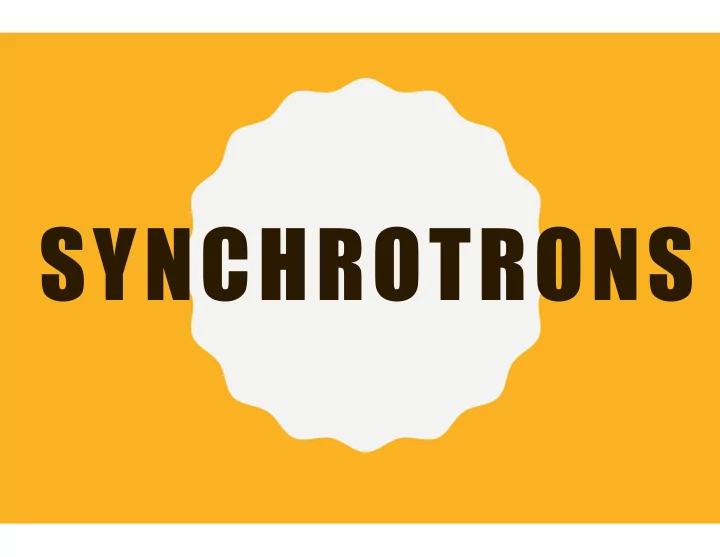

SYNCHROTRONS
WHAT IS A SYNCHROTRON? • It’s a particle accelerator, fixed R • Can be used as a collider or a experiment light source – Largest synchrotron is the LHC in Swizerland / France (27km) – This presentation focuses on light source • Particles are accelerated to relativistic speed – By E field in microwave • Magnetic field changes according to particle energy / speed to keep particles in the same circuit radius – Thus SYNchrotron • About 40 Synchrotrons in operation 𝐹↓𝑑 = 3 / 2 ℏ 𝑑/𝑆 𝛿↑ 3 =0.655 𝐹↓𝑓 [ 𝐻𝑓𝑊]↑ 2 𝐶[𝑈] 𝑆 = 𝐹/𝑑𝑓𝐶
SYNCHROTRON RADIATION • History – First observed in 1947 by GE as a waste product of high energy experiments – In 1960s, scientists started using the radiation in condensed matter research • Characteristics – When a charged particle is directed in a curved trajectory, EM radiations are generated in a narrow cone in the direction of motion of the charged particle – Brightest / most powerful source of light on earth • 8k MW/m 2 vs. 63 MW/m 2 of the sun – Broad, continuous spectrum of energy – Angular Collimation – Come in a series of flashes – Polarized • Due to Sokolov-Ternov effect N
Ba
Ba
Ba
Ba
MAJOR PARTS OF A SYNCHROTRON • Electron Gun • LINAC • Booster Ring • Storage Ring • Undulators / Wigglers • Beamline • Experimental Station N
ELECTRON GUN, LINAC AND BOOSTER • Accelerate particles from 0 to 0.99c • Energy of particle exits LINAC ~250MeV • Vacuum at ~100 Pa (less air pressure than ISS) • Klystron generate microwave – To group and accelerate particles • Accelerator is a tuned waveguide • Booster Ring boosts energy to 3 – 6 GeV within 1 second. Ba
STORAGE RING AND UNDULATORS • Electrons injected into storage ring from booster ring – 1 injection / second for 10 mins • Electrons stay in the storage ring for 4 – 12 hours • Particle energy range from 0.1 – 6 GeV – Typical is at 3GeV as light source • Undulators are highly precise magnets that periodically displace the electrons – Produce more photons and higher brilliance 𝜄 ~ 1 /𝛿√ 𝑜𝑂 , – About 5m long on the straight section
𝑄↓𝑡 = 𝑟↑ 2 𝑑 ⋅ 𝛿↑ 2 / 6 𝜌𝜁↓ 0 (𝑛↓ 0 𝑑↑ 2 )↑ 2 (𝑒𝑞/𝑒𝑢 )↑ 2 = 𝑟↑ 2 𝑑𝐹↑ 4 / 6 𝜌𝜁↓ 0 (𝑛↓ 0 𝑑↑ 2 )↑ 4 𝑠↑ 2 Ba
BEAMLINE & EXPERIMENTAL STATION • Beamline transports and “customizes” synchrotron radiation to the experiment target – Major component includes shutter, slits, aperture, mirrors, monochromator… – Complex design to get desired radiation • Experiments to study materials: (X-ray) Spectroscopy, (X-ray) Crystallography… Ba
Ba
WHO USE SYNCHROTRON? • Life Science – Pharmaceuticals – Protein, biomaterial – Ultra dilute pollutants • High Energy Physics / Astrophysics – Simulate high energy radiation • Engineering – Material stress (polarization) • Even humanities… (Non-Destructive) – Art history – Archaeology
FUTURE DEVELOPMENT • Most future X-ray sources will come from Free Electron Lasers (FEL) but not Synchrotrons – Higher peak power / brighter – Shorter pulse durations – Coherent light – Simultaneous users, reduce cost • Laser-Plasma Accelerators – Emax ~ 100 GV/m – Very compact design • Accelerator on a chip? – Dielectric Laser Accelerators (DLA)
REFERENCE
Recommend
More recommend